|
|
Famous Native Americans from History
Quanah Parker
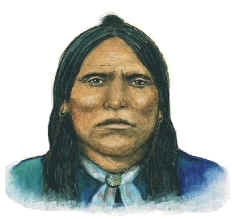
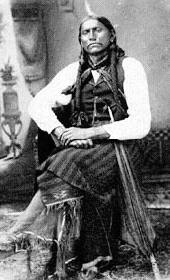
Quanah Parker was the last Chief of the Comanche Nation and never lost a battle
to the white man. His tribe roamed over the area where Pampas stands. He was
never captured by the Army, but decided to surrender and lead his tribe into
the white man's culture, only when he saw that there was no alternative.
His was the last tribe in the Staked Plains to come into the reservation system.
Quanah, meaning "fragrant," was born about 1850, son of Comanche Chief Peta
Nocona and Cynthia Ann Parker, a white girl taken captive during the 1836
raid on Parker's Fort, Texas. Cynthia Ann Parker was recaptured, along with
her daughter, during an 1860 raid on the Pease River in northwest Texas. She
had spent 24 years among the Comanche, however, and thus never readjusted to
living with the whites again.

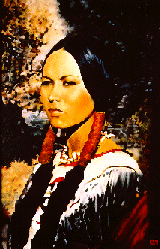
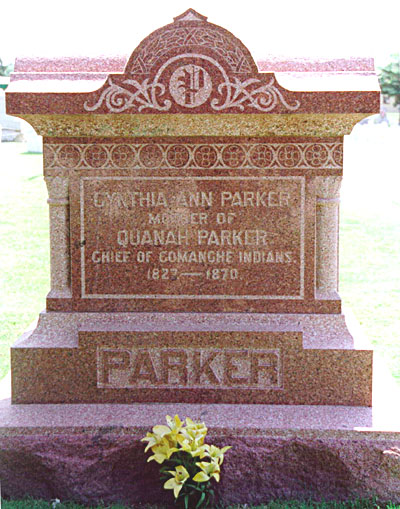
Cynthia Ann Parker - Quanah's White Mother
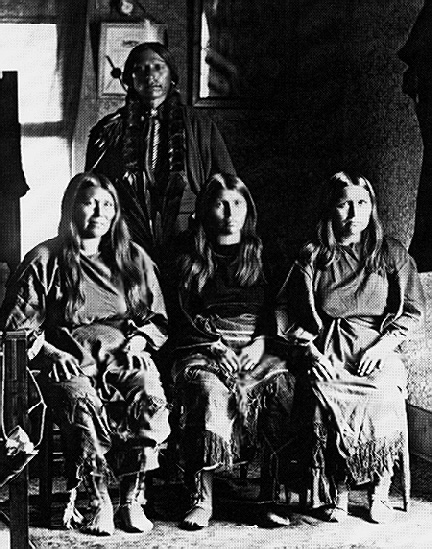
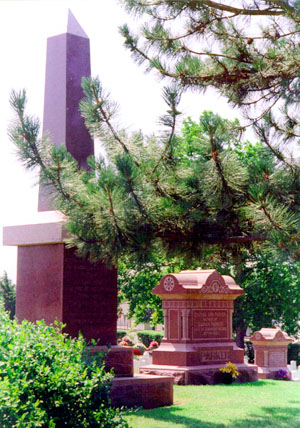
Quanah with 3 Wives Family of Quanah Parker
She died in Anderson County, Texas, in 1864 shortly after the death of her
daughter, Prairie Flower. Ironically, Cynthia Ann's son would adjust
remarkably well to living among the white men. But first he would lead a
bloody war against them.
Quanah and the Quahada Comanche, of whom his father, Peta Nocona had been
chief, refused to accept the provisions of the 1867 Treaty of Medicine
Lodge, which confined the southern Plains Indians to a reservation,
promising to clothe the Indians and turn them into farmers in imitation of
the white settlers.
Knowing of past lies and deceptive treaties of the "White man", Quanah
decided to remain on the warpath, raiding in Texas and Mexico and out
maneuvering Army Colonel Ronald S. Mackenzie and others. He was almost
killed during the attack on buffalo hunters at Adobe Walls in the Texas
Panhandle in 1874. The U.S. Army was relentless in its Red River campaign of
1874-75. Quanah's allies, the Quahada were weary and starving.
Mackenzie sent Jacob J. Sturm, a physician and post interpreter, to solicit
the Quahada's surrender. Sturm found Quanah, whom he called "a young man of
much influence with his people," and pleaded his case. Quanah rode to a
mesa, where he saw a wolf come toward him, howl and trot away to the
northeast. Overhead, an eagle "glided lazily and then whipped his wings in
the direction of Fort Sill," in the words of Jacob Sturm. This was a sign,
Quanah thought, and on June 2, 1875, he and his band surrendered at Fort
Sill in present-day Oklahoma.
Biographer Bill Neeley writes:
"Not only did Quanah pass within the span of a single lifetime from a Stone
Age warrior to a statesman in the age of the Industrial Revolution, but he
accepted the challenge and responsibility of leading the whole Comanche
tribe on the difficult road toward their new existence."
Quanah was traveling the "white man's road," but he did it his way. He
refused to give up polygamy, much to the reservation agents' chagrin.
Reservation agents being political appointees of the Federal Government,
their main concern was to destroy all vestiges of Native American life and
replace their culture with that of theirs. Quanah Parker also used peyote,
negotiated grazing rights with Texas cattlemen, and invested in a railroad.
He learned English, became a reservation judge, lobbied Congress and pleaded
the cause of the Comanche Nation. Among his friends were cattleman Charles
Goodnight and President Theodore Roosevelt. He considered himself a man who
tried to do right both to the people of his tribe and to his "pale-faced
friends".
It wasn't easy. Mackenzie appointed Quanah Parker as the chief of the
Comanche shortly after his surrender, but the older chiefs resented Parker's
youth, and his white blood in particular." And in 1892, when Quanah Parker
signed the Jerome Agreement that broke up the reservation, the Comanche were
split into two factions: (1). those who realized that all that could be done
had been one for their nation; and (2). those who blamed Chief Parker for
selling their country."
Quanah Parker died on February 23, 1911, and was buried next to his mother,
whose body he had reentered at Ft. Sill Military cemetery on Chiefs Knoll in
Oklahoma only three months earlier. For his courage, integrity and
tremendous insight, Quanah Parker's life tells the story of one of America's
greatest leaders and a true Texas Hero.

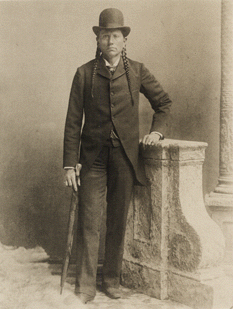
Quanah Parker
C. M. Bell, 1880s
Quanah Parker
C. M. Bell, 1880s
"Quanah Parker, for instance, is pictured in both tribal clothes and in a morning coat with an umbrella, pocket watch chain and derby. In one photograph he is supported by a rustic wall, in the other by a classical stucco simulation. He is posed near the same ornate column in both photographs.... Parker was Comanche, a wise crossblood leader at the turn of the last century who defended the use of peyote as a religious freedom. The narratives of his religious inspiration, his crossblood uncertainties, are not obvious in either of the photographs. His hair is braided in both pictures but the poses seem to be the causal representations of then and now, tradition and transition, or variations on the nostalgic themes of savagism of civilization. His eyes, not the costumes, are the narrratives..."
Sitting Bull
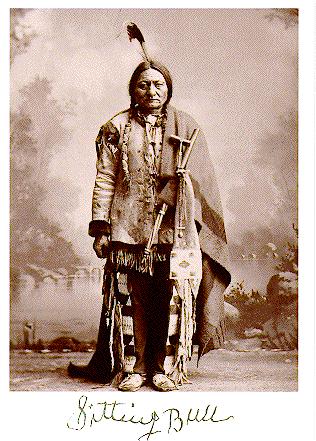
"Because of your bravery on the battlefield, and your reputation as the
bravest warrior in all our bands, we have elected you head chief of the
entire Sioux nation, head war chief. It is your duty to see that the nation
is fed, that we have plenty. When you say 'fight' we shall fight; when you
say 'make peace' we shall make peace." - Four Horns
Before given the name of Sitting Bull by his father, his parents named him
Slow because they did not see anything remarkable about him. When Slow was
14, he was considered very young to join a war party. However Slow was very
anxious for a chance to prove himself. As they rest of his party waited for
the enemy to approach nearer, Slow quickly charged towards an enemy on his
pony. The others changed strategy and followed his lead. The enemy warriors
were so shocked at the boldness of the attack, that they began to retreat.
Because his father was so proud of his son's early victory, he gave the name
Sitting Bull to his son that the Buffalo God had given him. The Indians
thought of the Buffalo as a headstrong, stubborn creature that was afraid of
nothing. A creature that has great endurance, courage and strength. These
qualities were fighting qualities that people saw in Sitting Bull. When the
Hunkpapa Sioux tribe began losing respect and faith in the Chiefs of their
tribe, Four Horns decided it was time that a new chief was to be chosen. A
chief that would restore the honor of and rebuild the people's respect would
be Sitting Bull. He was well known as an able buffalo hunter, a brave
warrior who led charges against enemies, and he was a popular figure within
the camp. He also had a reputation as a peacemaker, settling disputes among
his people. Sitting Bull felt for the poor and weak people of his tribe and
showed his compassion by sharing food and even giving away his horses. He
was a sociable man who always had a good story or joke ready for those who
would listen. Being extremely religious, it is said that Sitting Bull
received everything he prayed for, and his prophecy gift was uncanny.
Chronology of Sitting Bull's Life
1831 Born near present South Dakota
1845 Joins war party and counts first coup receives the name Sitting Bull
from his father
1856 Kills Crow chief in combat Becomes chief of the Strong Hearts warrior
society
1857 Adopts captive Assiniboin boy as a brother
1864 Participants in the Battle of Killdeer Mountains and the Battle of the
Badlands
1865 Fights US troops in the Battle of Powder River
1867 Inaugurated head chief of the Teton Sioux
1868 Negotiates the Treaty of Laramie with Father Pierre Jeane DeSmet
1869 Spares Frank Grouard and adopts him as a brother
1876 Assembles a force of Plain Indians and prepares for war against the US
Army Performs the Sun Dance ritual and prophesies victory Defeats General
Cook in the Battle of the Rosebud Defeats General Custer in the Battle of
Little Bighorn Meets with Colonel Miles
1877 Takes his people to Canada
1878 Meets with the US Commission and refuses to leave Canada
1881 Returns with his people to the United States and surrenders at Fort
Buford
1881-1883 Held in confinement at Fort Randall
1885 Returns with his people to the United States and Canada with Buffalo
Bill Cody's Wild West Show
1888 Resists the proposed breakup of the Great Sioux Reservation
1889 Attempts unsuccessfully to block cession of land to the government
1890 Killed by the Standing Rock Indian police during an attempted arrest,
two weeks before the massacre at Wounded Knee Creek
Crazy Horse

"My son has been against the people of unknown tongue. He has done a brave
thing; for this I give him a new name, the name of his father, and of many
fathers before him. I give him a great name. I call him Crazy Horse."
- Crazy Horse's Father
Before his father had given him the name of Crazy Horse, he was called Curly
(because of his light curly brown hair). As a baby, Crazy Horse was said to
be an unusual boy since he didn't resemble his father or his mother. Being
viewed as unusual or different would be a common view the people had of
Curly while he was growing up. He avoided boasting about his
accomplishments, and also avoided displays of pride, wealth and emotion. He
tried to direct attention away from himself by dressing plainly, and
speaking as little as possible. The men and women who knew Curly referred to
him as a private boy who rarely revealed his thoughts to others. However,
the people would later learn, that this quiet, serious attitude was part of
what made him successful. He fought with a cool head, and his people learned
to admire him for it. The future of his people was put ahead of his personal
glory. He was known for keeping casualties of his people down, and also for
seeing to the safety of the wounded. It comes to no great surprise that this
"strange boy" who had the characteristics of a great leader, was made Chief
of his people.
Chronology of Crazy Horse's Life
1841 Born near present day South Dakota Nicknamed Curly
1851 Attends Great Fort Laramie Treaty Council Sioux agree to allow whites
to travel across land in return for goods
1854 Curly witnesses Grattan massacre receives vision telling his future as
a warrior
1857 Attends Great Teton Council Hankpatila Oglalas move into Powder River
country
1858 Displays outstanding courage during his first important battle earns
the name Crazy Horse
1865 Allied Cheyenne and Sioux forces raid Julesberg, Colorado Crazy Horse
rescues Sioux being driven from their camps at Fort Laramie, Wyoming
1866-1868 Fights US Troops at Forts Phil Kearny and C.F. Smith
1868 Sioux leaders sign treaty with United States guaranteeing the Indians
hunting rights in the Black Hills and the Powder River region
1870 Crazy Horse's mentor and friend, Hump, dies during battle with
Shoshones Crazy Horse is wounded in a fight over Black Buffalo Woman, the
wife of No Water
1871 Younger Brother, Little Hawk dies Marries Black Shawl Black Shawl gives
birth to daughter: They Are Afraid of Her
1872 Along with Sitting Bull, they raid Northern Pacific Railroad expedition
near the Yellowstone River
1874 They Are Afraid of Her dies George Armstrong Custer leads expedition
into Black Hills and reports on the findings of gold
1875 Whites try to purchase Sioux territory at Lone Tree Council US
government orders northern Sioux onto reservations
1876 Joins Sitting Bull and thousands of Sioux and Cheyenne warriors at a
great encampment in the Little Bighorn Valley Defeats General Custer Cook at
Battle of the Rosebud River Wipes out Custer and his troops at the Battle of
the Little Bighorn
1877 Surrenders at Fort Robinson (present day Nebraska) Killed while
Imprisoned at Fort Robinson
Red Cloud
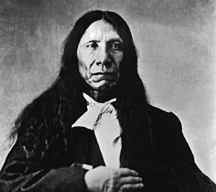
"Look at me. I was a warrior on this land where the sun rises, now I come
from where the sun sets. Whose voice was first surrounded on this land - the
red people with bows and arrows. The Great Father says he is good and kind
to us. I can't see it..." - Red Cloud
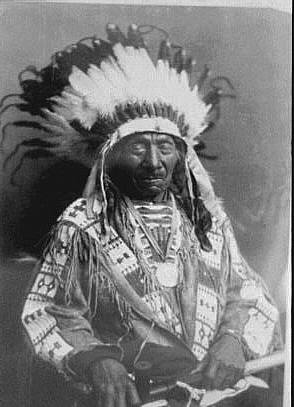
Very little is known about Red Cloud's childhood, but it is very believable
that he grew up in the same loving environment that surrounded many Sioux
children. As Red Cloud was growing up, he was involved in many games that
taught him how to be a skilled fighter. Red Cloud also had an important
ability for telling tales in a lively and convincing manner. This ability
was almost as significant as successfulness on the battlefield since
speaking ability was one of the distinctions where a young boy could rise to
a position of leadership. It was this ability that would help him gain the
loyalty of thousands of warriors. Red Cloud's ability to fight as well as
his determination to protect his people earned him a reputation as a bold
and spirited fighter. Red Cloud is considered to be one of the greatest
warriors and Chiefs of the Oglala.
Red Cloud was in a group of Indians which went to Washington in 1870, and his actions and speech indicated that he had changed his ideas about war and was an advocate of peace. His trip was called Red Cloud's Peace Crusade. He was a guest of President Ulysses S. Grant in the White House, and then went to New York, where on June 16 he made an address at the Cooper Institute, appearing before a capacity audience.
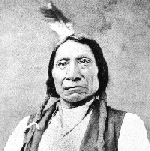
In reporting the speech, a front page story in the New York Times of June 17, 1870, commented:
No one who listened to Red Cloud's remarkable speech yesterday can doubt that he is a man of very great talents. He has spent his life fighting the battles of his people, and one day he is transplanted to Cooper Institute, and asked to put on a clean shirt, a new waistcoat, a high crowned hat, and then make a speech. His earnest manner, his impassioned gestures, the eloquence of his hands, and the magnetism, which he evidently exercises over his audience, produced a vast effect on the dense throng which listened to him yesterday. "You have children, and so have we. We want to rear our children well, and ask you to help us in doing so." It seems to us that this is not an unreasonable request even though it does come from a "savage."
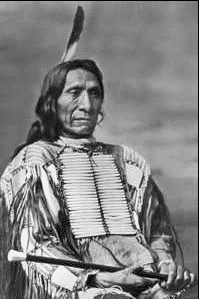
Red Cloud liked to say, "The President is a friend of mine." He aged rapidly while living on the reservation and became blind and decrepit. He died December 10, 1909.
'I Represent the Whole Sioux Nation, and They Will Be Bound by What I Say"
My brothers and my friends who are before me today, God Almighty has made us all, and He is here to hear what I have to say to you today. The Great Spirit made us both. He gave us land, and he gave you land. You came here and we received you as brothers. When the Almighty made you, He made you all white and clothed you. When He made us, He made us with red skins and poor. When you first came we were very many and you were few. You do not know who appears before you to speak. He is a representative of the original American race, the first people on this continent. We are good, and not bad. The reports that you get about us are all on one side. You hear of us only as murderers and thieves. We are not so. If we had more lands to give you, we would give them, but we have no more. We are driven into a very little island, and we want you, our dear friends, to help us with the Government of the United States.
The Great Spirit made us poor and ignorant. He made you rich and wise and skillful in things which we know nothing about. The good Father made you to eat tame game, and us to eat wild game. Ask any one who has gone through to California. They will tell you we have treated them well. You have children. We, too, have children, and we wish to bring them up well. We ask you to help us do it.
At the mouth of Horse Creek, in 1852, the Great Father made a treaty with us, We agreed to let him pass through our territory unharmed for fifty-five years. We kept our word. We committed no murders, no depredations, until the troops came there. When the troops were sent there trouble and disturbance arose. Since that time there have been various goods sent from time to time to us, but only once did they reach us, and soon the Great Father took away the only good man he had sent to us, Colonel Fitzpatrick. The Great Father said we must go to farming, and some of our men went to farming near Fort Laramie, and we were treated very badly indeed.
We came to Washington to see our Great Father that peace might be continued. The Great Father that made us both wishes peace to be kept; we want to keep peace Will you help us? In 1868 men came out and brought papers. We could not read them, and they did not tell us what was in them. We thought the treaty was to remove the forts, and that we should then cease from fighting. But they wanted to send us traders on the Missouri. We did not want to go to the Missouri, but wanted traders where we were. When I reach Washington, the Great Father explained to me what the treaty was, and showed me that the interpreters had deceived me All I want is right and justice. I have tried to get from the Great Father what is right and just. I have not altogether succeeded. I want you to help me get what is right and just. I represent the whole Sioux nation, and they will be bound by what I say. I am no Spotted Tail, to say one thing one day and be bought for a pin the next. Look at me, I am poor and naked, but I am the Chief of the nation. We do not want riches but we do want to train cur children right. Riches would do us no good. We could not take them with us to the other world. We do not want riches, we want peace and love,
The riches that we have in this world, Secretary Cox said truly, we cannot take with us to the next world. Then I wish to know why commissioners are sent out to us who do nothing but rob us and get the riches of this world away from us? I was brought up among the traders and those who came out there in the early times treated me well and I had a good nine with them. They taught us to wear clothes and to use tobacco and ammunition. But, by and by, the Great Father sent out a different kind of men; men who cheated and drank whiskey; men who were so bad that the Great Father could not keep them at home and so sent them out there.
I have sent a great many words to the Great Father but they never reached him. They were drowned on the way, and I was afraid the words I spoke lately to the Great Father would not reach you, so I came to speak to you myself; and now I am going away to my home. I want to have men sent out to my people whom we know and can trust. I am glad I have come here. You belong in the East, and I belong in the West, and I am glad I have come here and that we understand one another. I am very much obliged to you for listening to me. I go home this after-noon. I hope you will think of what I have said to you. I bid you all an affectionate farewell.
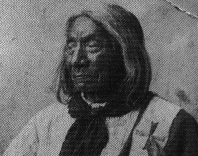
This is his farewell address to the Lakota people on July 4, 1903 "My sun is set. My day is done. Darkness is stealing over me. Before I lie down to rise no more, I will speak to my people. "Hear me, my friends, for it is not the time for me to tell you a lie. The Great Spirit made us, the Indians, and gave us this land we live in. He gave us the buffalo, the antelope, and the deer for food and clothing. We moved our hunting grounds from the Minnesota to the Platte and from the Mississippi to the great mountains. No one put bounds on us. We were free as the winds, and like the eagle, heard no man's commands. "I was born a Lakota and I shall die a Lakota. Before the white man came to our country, the Lakotas were a free people. They made their own laws and governed themselves as it seemed good to them. The priests and ministers tell us that we lived wickedly when we lived before the white man came among us. Whose fault was this? We lived right as we were taught it was right. Shall we be punished for this? I am not sure that what these people tell me is true. As a child I was taught the Taku Wakan (Supernatural Powers) were powerful and could do strange things. This was taught me by the wise men and the shamans. They taught me that I could gain their favor by being kind to my people and brave before my enemies; by telling the truth and living straight; by fighting for my people and their hunting grounds. "When the Lakotas believed these things they were happy and they died satisfied. What more than this can that which the white man offers us give? "Taku Shanskan is familiar with my spirit and when I die I will go with him. Then I will be with my forefathers. If this is not in the heaven of the white man I shall be satisfied. Wi is my father. The Wakan Tanka of the white man has overcome him. But I shall remain true to him. "Shadows are long and dark before me. I shall soon lie down to rise no more. While my spirit is with my body the smoke of my breath shall be towards the Sun for he knows all things and knows that I am still true to him."

Guardhouse and Monument on site where Crazy Horse was bayoneted
at Fort Robinson, Neb. Sept. 5, 1877.
Chronology of Red Cloud's Life
1822 Born in western Nebraska
1841 Kills Bull Bear (Chief of the Koya Oglala)
1842 Leads first war party Marries Pretty Owl
1851 Plains tribes meet government agents at the first Fort Laramie treaty
council Indians grant settlers right of way through territory in exchange
for government annuity
1854 US troops kill Conquering Bear (chief of the Sioux) at Fort Laramie
Brul and Oglala warriors kill John L. Grattan and 20 of his men in the
Grattan Massacre
1855 General William S. Harney kills 86 Indians camped with Brul chief
Little Thunder on the Bluewater River
1864 Colorado volunteers under Colonel John H. Chivington kill 130 Cheyennes
at Sand Creek, Colorado
1866 Red Cloud's warriors lay siege to Fort Phil Kearny December: wipe out
Captain William Fetterman and his 80 man command
1867 US troops repulse Red Cloud's forces in the Wagon Box Fight near Fort
Phil Kearny
1868 Red Cloud signs treaty ending warfare US Government agrees to withdraw
troops from Lakota lands near Powder River
1870 Red Cloud travels to Washington to negotiate for trading rights at Fort
Laramie
1873 Settles at Red Cloud Agency on the White River
1876 Lakota, Cheyenne and Arapaho forces destroy General George Armstrong
Custer and his men at the Battle of the Little Bighorn Accused of supporting
the campaign, Red Cloud and followers are arrested
1878 Red Cloud's people move to Pine Ridge Agency on the White Clay River
1889 US Officials persuade the Sioux to relinquish 11 million acres of land
to non-Indian settlers
1890 US troops under Colonel James Forsyth kill more than 150 Lakotas at
Wounded Knee Creak
1909 Red Cloud Dies at Pine Ridge Agency
Sacajawea
Enemies from another tribe kidnapped Sacajawea who was a Shoshone Indian.
These Indians sold her to a French-Canadian trader named Toussaint
Charbonneau. Charbonneau was hired as an interpreter when they joined the
Lewis and Clark expedition as it passed up the Missouri River in 1804.
However, it was Sacajawea who proved useful when she saved them from harm
from the Shoshone Indians. She was also able to get food and supplies that
the travelers needed from her relatives she met when crossing the
Continental Divide. She was an extraordinary woman and there are many
memorials dedicated to her, the most famous one located in Washington Park,
Portland, Oregon.
Black Elk
"My friend, I am going to tell you the story of my life, as you wish; and if
it were only the story of my life I think I would not tell it; for what is
one man that he should make much of his winters, even when they bend him
like a heavy snow? So many other men have lived and shall live that story,
to be grass upon the hills. - Black Elk
Black Elk was born into a tribe of the Plains Indians, the Oglala Sioux. He
had five sisters and one brother. He had many children, but the one
discussed in this essay is his daughter, Lucy Looks Twice. The Sioux were
hunters, and they relied mainly on the buffalo. Buffalo was their main
source for food as well as shelter and clothing. The Sioux lived throughout
the midwestern plains of North America, until they were put on Pine Ridge
reservation in South Dakota.
At the age of nine, Black Elk received a great vision. This vision portrayed
the Powers of the World, each giving Black Elk a gift and a special power.
The Grandfathers, represented the powers of north, south, east, and west.
With the gifts that he received, Black Elk was given the center of the
nations hoop. According to the book, Black Elk Speaks, by John Neihardt, the
grandfathers said to Black Elk, "Behold a nation; it is yours." And a voice
said, "Behold, they have given you the center of the nation's hoop to make
it live."
Black Elk took part in many historical events, like the Battle of Little Big
Horn. As an adult Black Elk became a medicine man and a prominent member of
his tribe. Thirty years before his death, Black Elk became a Catholic. His
religion was very important to him. In the book, Black Elk; Holy Man of the
Oglala by Michael Steltenkamp, Lucy Looks twice recalls that he father had
"suffered a lot," and had experience inner confusion. Black Elk knew that
something was wrong in his life because he suffered socially, physically,
and psychologically. Black Elk soon had to visit the hospital due to ulcers.
While there he received the holy sacrament, and never suffered from his
ulcers again. This instance, and with the encouragement of his friend, Kills
Brave, Black Elk converted to Catholicism. On December 6th, 1904 Black Elk
was baptized, and he gave up his medicine forever. Because he was baptized
on the feast of Saint Nicholas, Black Elk was given the christian name,
Nicholas Black Elk.
These last years of Black Elk's life are very important, because he was a
devout catholic. Knowing about Christ and receiving communion were what he
held sacred. Black Elk spent many years of his life as a catechist. He often
walked for miles to summon a priest to administer last rights. Lucy states
that, "If anything ever went wrong with my children, if he prayed, I knew
everything would be all right. He had a way, since he loved little
children." Black Elk's religion was so strong that it had a drastic impact
on many lives. Many of the people Black Elk used to care for as a medicine
man came to him for advice, and many followed in his direction.
Chronology of Black Elk's Life
1863 (December) Born on the Little Powder River
1873 Had the Great Vision
1876 Battle at the Little Bighorn River
1882 Became a medicine man
1886-1889 Traveled to Europe
1890 Massacer at Wounded Knee
1931 Told Life Story to John Neihardt
1950 Died on Pine Ridge Reservation, South Dakota
Chief Joseph
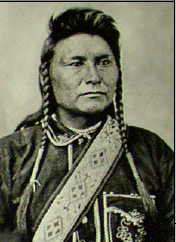
Chief Seattle
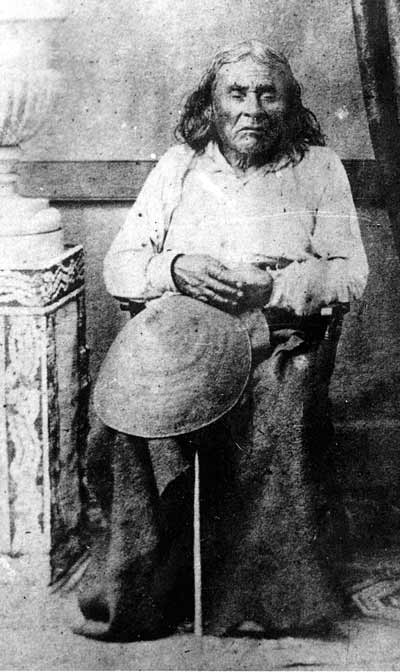
This photo of an elderly Chief Seattle is the only known image of the Duwamish chief.
Cochise
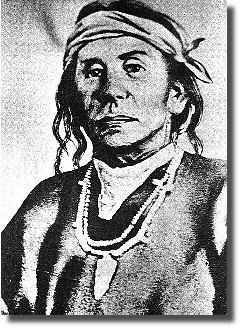

Geronimo
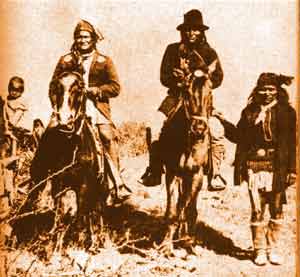
Geronimo riding with Naiche
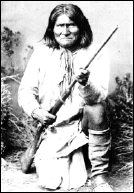
Geronimo was the most legendary and feared of all the Apache warriors. He was known as a chief but he wasn't. He was a very powerful medicine man and shaman that could foretell the future. He was a war leader for a small group of Apaches in Southeastern Arizona during the 1850's through 1880's. He was born with the name Goyahkla, which means "one who yawns." However some Ft. Sill Apaches gave the meaning as "intelligent, shred and clever." He was given his name Geronimo from the fear he produced in his Mexican enemies. As he would attack they would yell out the name of their patron saint Jerome. This translated into Geronimo, so he took this as his nickname. One of the first spirit communications he received was shortly after the death of his family in Kaskiyeh. He went to a top of a mountain and heard a voice call his name four times. The voice told him "No gun can ever kill you. I will take the bullets from the guns of the Mexicans, so they will have nothing but powder and I will guide your arrows." He was wounded many times but never killed by a bullet. He died on February 17, 1909 in Ft. Sill, OK. His only last wish was to return to Arizona, to his homeland. He was never allowed to return to Arizona and died a prisoner of war.
Naiche
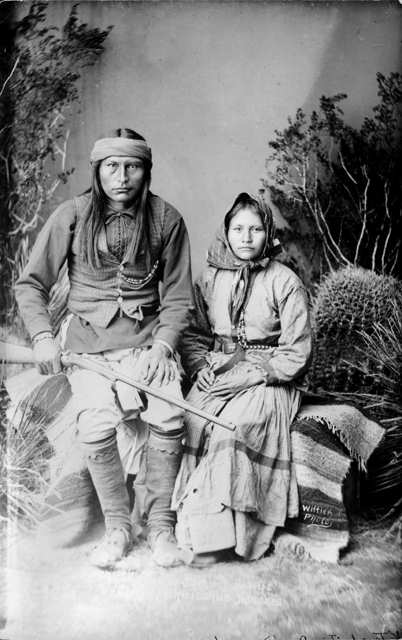

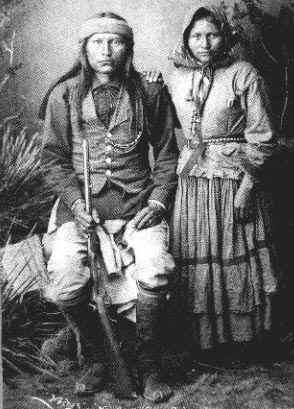
Naiche was the youngest son of Cochise the Great Apache Chief. He was very tall for an Indian standing over 6'. He was the leader, by his noble bloodline, of a small band of runaway Apaches that included Geronimo, Chappo (Geronimo's son), Fun, Nana, Cayetano, Yanozha, Chihuahua, Haozinne, Perico (Geronimo's brother) and others that had fought off over 5,000 US Troops which relentlessly attacked them for over 2 years. Naiche lacked the drive of Geronimo, the military genius of Cochise or Victorio and the statesmanship of Mangus Colorado. He never succeeded his father or brother as chief of the Chiricahua Apaches. Captured with Geronimo and sent to Florida he remained as a military prisoner at Ft. Sill until his death.
Mangas
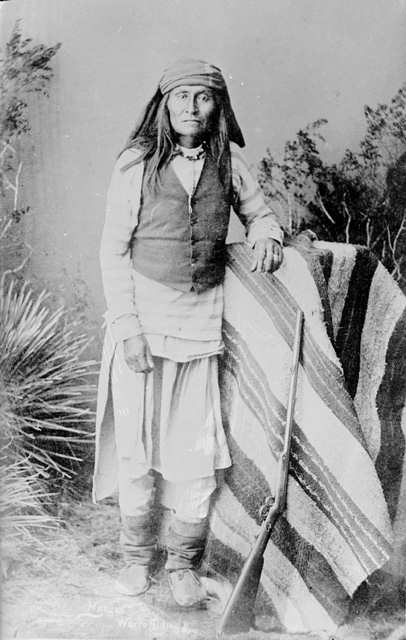
This photo is of Mangas, son of Mangus Colorado who was the leader of the Bendonkohe tribe of Apaches to which Geronimo belonged. All the Apache people admired him. Geronimo as would characterize the murder by the whites of Mangus Colorado, "perhaps the greatest wrong ever done to the Indians." He was lured to a peace conference by white gold miners in January of 1863. They thought if they held him hostage that they would be assured safe passage through the area. During the night he reportedly tried to escape and was shot. When discovered by the Apaches, who followed Mangus, it was probably the last straw that set off the hatred between the Apaches led by Geronimo and the whites. Following the death of Mangus Colorado, according to Geronimo, he became Chief of the Bendonkohe Tribe. However, he was not born into royalty so the true leader of the runaway band of Apaches that caused so much trouble for the American Troops was probably Naiche.
Nana
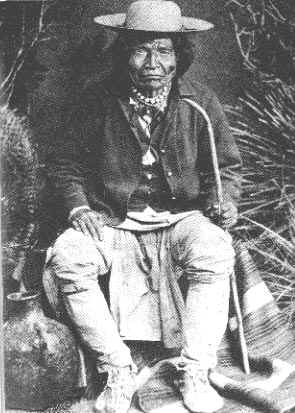
Nana was married to Geronimo's sister. To his people he as a wise kind grandfather type figure, but as far as the whites were concerned he was uncomprimising. Nana was a Warm Springs Apache under Victorio but was always close to the Bendonkohe tribe. During the surrender by Geronimo to Crook in 1886, Nana was given to the Cavalry as a good faith token that they were ready to surrender.
Chief Pontiac
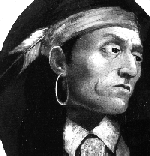
Victorio
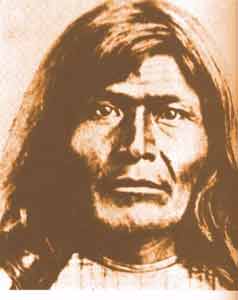
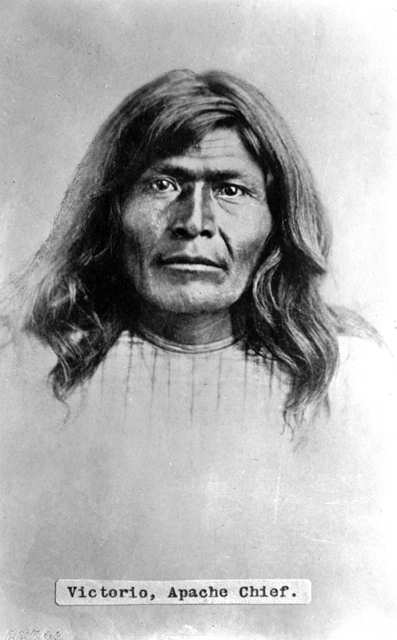
Born into the Warm Springs Apache tribe in New Mexico, Victorio was one of the most ruthless and feared Indians in the Southwest. He led a small band of warriors on raids into Northern Mexico, Eastern Arizona and Southwestern New Mexico. He was always a warm friend to Geronimo and Naiche. All the Apache tribes admired him. This is the only known photo of the great Chihenne Leader.
Gall
Hunkpapa Sioux
Born about 1840 - Died December 5, 1894
GALL was one of the greatest of the Hunkpapa Sioux chieftains, and some historians consider him to be the peer of the famous Red Cloud and of Spotted Tail. Gall was one of the leaders of the Hunk-papa Sioux during the time of the fabulous Sitting Bull.
Gall was a superb specimen of manhood, rugged and able. On one occasion he had stolen some ponies and a detachment of a hundred soldiers was sent to his village to arrest him. The soldiers surrounded the village at about 2 A.M., announcing that they wanted Gall. He was aroused, stuck his head out of his tipi, and was promptly shot at by one of the soldiers.
Gall dashed to the back of the tipi, slashed a hole, and started to leap out. Soldiers, armed with rifles and bayonets, were all around, and slammed him to the ground. They clubbed, stomped, and stabbed him, and one soldier had to put his foot on Gall's body to retrieve his bayonet. Thinking Gall dead, they left him lying in the snow.
Other Indians in the camp would not touch his body, and they quickly moved their tipis to another location. Gall later revived, and in spite of his terrible wounds and the fact that he was nearly naked in the cold and snow, made his way to the lodge of a friend some twenty miles away. The friend cared for him until he recovered from his ordeal, but one of the wounds remained open for more than a year.
After this affair, Gall carried a lasting hatred for the whites, and finally died December 5, 1894, as a result of his horrible wounds. His birth has been recorded as c. 1840. Tecumseh 1768?-1813, chief of the Shawnee, b. probably in Clark co., Ohio. Among his people he became distinguished for his prowess in battle, but he opposed the practice of torturing prisoners. When the United States refused to recognize his principle that all Native American land was the common possession of all the Native Americans and that land could not rightly be ceded by, or purchased from, an individual tribe, Tecumseh set out to bind together the Native Americans of the Old Northwest, the South, and the eastern Mississippi valley. His plan failed with the defeat of his brother, the Shawnee Prophet, at Tippecanoe (1811). Though Tippecanoe was, properly speaking, a drawn battle, it marked the collapse of the Native American military movement. In the War of 1812, Tecumseh allied himself with the British and was made a brigadier general. He led a large force of Native Americans in the siege of Fort Meigs, covered Gen. Henry Procter's retreat after the American victory on Lake Erie, and lost his life in the battle of the Thames, in which Gen. William Henry Harrison overwhelmed Procter and his Native American allies. Tecumseh had great ability as an organizer and a leader and is considered one of the outstanding Native Americans in American history. See biographies by Benjamin Drake (1841, repr. 1969), J. M. Oskison (1938), and Glenn Tucker (1956, repr. 1973); C. F. Klinck, Tecumseh: Fact and Fiction in Early Records (1961); A. W. Eckert, The Frontiersmen (1967).
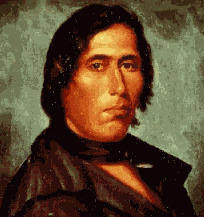


Attakullakulla - Cherokee chief in the 18th century, during the time of war between the Cherokee Nation and the American colonies. Chief Black Kettle - Short fact sheet on the Southern Cheyenne chief who, despite broken promises and attacks on his own life, was regarded as a great leader with a unique vision for coexistence between mainstream America and the plains Indians. Chief Gall - Short fact sheet on the Hunkpapa chief who led the Lakota in a long war against the United States, and later encouraged his people to accept assimilation once confined on reservations. Chief Ouray - Revered today as one of the Ute's greatest leaders, Chief Ouray led the Southern Ute Tribe during the mid 1800s. Dr. Susan LaFlesche Picotte - Biographical sketch about the first Native American woman physician. Dragging Canoe, Cherokee War Chief - Chief who was fought settlers in the Tennessee area during the late 1700's, by D. Ray Smith. First Americans in the Arts - Annual awards ceremony gives scholarships to American Indian college students and honors past and present Native American Indian performers. Searchable event listings, merchandise, mediography, readers' poll and links. Great Chiefs and Leaders - Browseable database featuring profiles of prominent modern and historical figures. Some with black and white photos and images, and links. James Vann - Mixed-blood Cherokee who was one of the richest men in the Western Hemisphere in the early 1800's. Logan Fontenelle - Simple information of the 19th century Omaha Indian chief from a textbook for children. Major Ridge - Cherokee chief, led Lighthorse Patrol and signed the Treaty of New Echota. Native American Athletes - Profiles Native American athletes from 1760 - 1977 focusing on track and field, hockey, and boxing. Native American Authors - Index by tribe. From the Internet Public Library. Native Americans in Film: A Short FAQ - Lists tribal affiliations of famous actors, and films with native language dialogue. Private Pierre Cruzatte - Biography of the French-Omaha voyager on the Lewis and Clark expedition. Sarah Winnemucca - Paiute leader, warrior, and interpreter, 1844-1891. Article with historical photos. Extensive list of related links. Sequoyah (a.k.a George Gist) - Crippled from birth, this scholar created the Cherokee syllabary known as the "Talking Leaves." Standing Bear: Indian Civil Rights Hero - Brief article about the Chief of the Ponca Indians when his people were displaced to the Indian Territory of Oklahoma. Tahtonka People Index - Links to biographical and historical sketches of prominant Native Americans. William C. Thompson et al vs. Choctaw Nation 1895-1909 - Texas Choctaw leader Captain William Clyde Thompson and his fight with the Dawes Commission for Choctaw enrollment. |
|
|
|
|
 Native American Nations
Native American Nations
